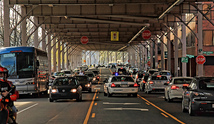Support streetcars at Georgetown ANC meeting tonight
ANCs across DC have been weighing in on streetcars recently, with some opposing streetcars with any wires in their communities and otherswelcoming streetcars even with a wire on some streets. Tonight, Georgetown weighs in at its ANC meeting at 6:30pm, when the ANC considers both the planned streetcars on K Street under the Whitehurst and the “planned to be studied” streetcars on Wisconsin.
The K Street portion is significant, as it is the ultimate western end of the K St/H St/Benning Rd route that will soon be started in Northeast DC. This route is part of Phase 1 of DDOT’s streetcar plan, and the route overlaps much of the busiest bus route in the city, the 30s buses.
In Georgetown, the line would only travel long K Street, under the elevated Whitehurst Freeway. That would seem to address any concerns about historic vistas, since the road has a giant overhead freeway already. However, According to a Georgetown ANC rep, some are concerned about an overhead wire on K, since many Georgetowners want to remove the Whitehurst. If that happened, the wires would become more visible.
This concern may lead to a resolution opposing streetcars on K if it means a wire under the Whitehurst. I too want to remove Whitehurst, but the way to get there is not by opposing alternative transportation options.
Here are a few reasons why you should show up at tonight’s meeting and support streetcars on K, even if they require a wire under the Whitehurst.
Reducing the need for the Whitehurst will facilitate its removal. The main roadblock to removing the Whitehurst is the fear that Whitehurst traffic will end up in the Georgetown and Foggy Bottom neighborhoods. While this fear is largely ungrounded, given that 14-25% of the demand for a freeway disappears when the freeway is removed, this elasticity goes way up when ready transit alternatives are available. When New York’s West Side Highway came down, a full 53% of the traffic vanished, thanks to plentiful public transit alternatives.
Streetcars reduce traffic and parking congestion. First, drivers don’t double-park on tracks. Second, streetcars will pull completely out of traffic at stops (DC streetcars will run in mixed traffic). Third, streetcars hold more people than buses. Finally, people ride streetcars who wouldn’t ride buses.
In fact, studies show that 30-40% of streetcar riders would have otherwise driven, whereas only 5% of bus riders would have otherwise driven. That’s because streetcars provide smoother rides, are more fun to ride, and the tracks remind people that the routes exist.
Georgetowners want more transit. While Georgetown sometimes gets a reputation of opposing transit, the facts are very different. 20% of households and 1/3 of rental households in Georgetown own no car, and over half of Georgetowners don’t drive to work.
This is roughly the same as the city average, despite the absence of a Metro stop in Georgetown. The busiest bus route runs through Georgetown, and Georgetowners rallied to extend and keep the Circulator on Wisconsin Ave.
This shouldn’t come as a surprise. What kinds of folks would move to a neighborhood where you can visit multiple parks, schools, stores, libraries and so on within a 5 minute walk? Folks like my carless family. I bus to my software gig in McLean, my wife buses to her Sibley job, and we bus our 18-month-old to the Wilson Aquatic Center when he isn’t frolicking in one of 5 Georgetown playgrounds.
If the Georgetown ANC is trying
to represent Georgetowners — those who want more transit, those who want less traffic and parking congestion, and those who want to remove the Whitehurst — then supporting streetcars on K, even with a wire under the Whitehurst, is the right move.
The ANC meeting is tonight, 5:00 6:30 pm at the Georgetown Visitation School, 35th and Volta Place, in the Heritage Room. It’s in the first building on the left by the gatehouse, on the 2nd floor.

